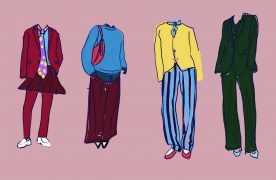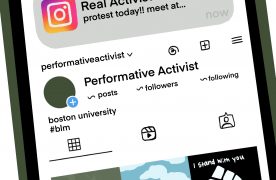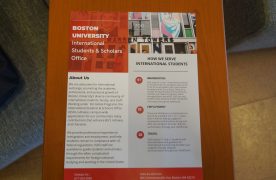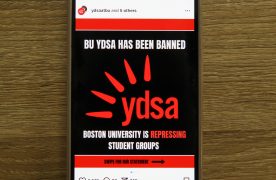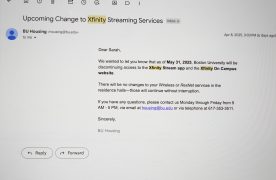Though Boston University’s student-created porn magazine came onto the scene with a bang in 2005, the controversial publication, along with other formerly popular student sex magazines in the Boston area, seems to have disappeared from everyone’s radar.
When boink, a magazine whose tagline is ‘college sex by the people having it,’ was launched in 2005 by former BU student Alecia Oleyourrk, its controversy on campus gave the magazine boundless publicity and attention, eliciting a comment from Dean of Students Kenneth Elmore that ‘the University does not endorse, nor welcome, the prospective publication.’ Since then, however, talk about the up-and-coming student porn industry has died down, and sex magazines that once caused a commotion are now mostly silent.
Even though boink seems to still be available for online purchase, according to its website, a Newbury Comics employee said the store hasn’t received any new issues ‘in a while.’ Meanwhile, though it does not consider itself a pornography magazine, Harvard’s sex magazine, H-Bomb, which was launched in 2004 by two Harvard students, has not recently appeared on magazine racks, though one of its editors, Harvard sophomore Brandon Perkovich, said the next issue is due out in ‘a few weeks.’
After all of the hype about on-campus sex magazines, they seemed to have fallen short of the hype and potential that was expected of them, and professionals have speculated that a bad economy may not be the only reason college students did not buy into the idea of seeing their peers naked on paper.
PRINT VS. INTERNET
As newspapers find ways to create a business model that can make free online content profitable, student pornography is facing the same problem, according to Gail Dines, a professor of sociology and women’s studies at Wheelock University.
Dines, who has written a book and numerous articles on pornography and the media, said the porn industry as a whole must now compete with the content consumers can get for free online. Student sex magazines, specifically, may have a harder time competing with online content because they cannot make their material as hardcore as that offered on the Internet, she said.
‘I don’t think [the student sex magazines] could have gone as hardcore as they needed to,’ Dines said. ‘They had to maintain a sense that is fun for everyone.’
Dines said the unregulated Internet has raised the standard of how vulgar and hardcore pornography needs to be to attract consumers, making future student sex magazines less than viable.
‘I don’t think there’s much of a future for it,’ she said. ‘I think a magazine like that can’t keep up with the porn market. It was too tame.’
In addition to free photographic material online, there is also a growth of independent student video pornography, making it even harder for a magazine to compete.
Julie Hall, who has modeled for boink, said though she is not involved in the video porn industry, she has heard of some college students who are creating their own videos and posting them online as a way to make extra money.
‘People don’t realize how much these people who are in porn in the video industry make,’ Hall, a College of Communication junior, said. ‘I think a lot of kids have turned to that online stuff to make extra money.’
SELLING WHAT STUDENTS WANT
While the economy and Internet have hurt all magazines, some people said they didn’t think the magazines could successfully market themselves to their student audience.
Hall said male students may not have taken to the magazine as well as they were expected to because its models are not as ‘done up’ as those in professional porn magazines.
‘Guys are going to pay for the done up Playboy and Hustler girls,’ Hall said. ‘The girls in our magazine were more natural, and I think that might not be as appealing.’
Hall said she thinks the initial attraction to the magazine may have been mostly because of the interest in possibly seeing a classmate, lab partner or study buddy posing on the pages of the magazine. However, after the initial appeal, Hall said she could understand why students might lose interest.
Similarly, COM advertising professor Judith Austin said after initially sparking interest, a magazine that bares it all and leaves nothing to the imagination could become wearisome to students who may be looking for more substance in the literature they decide to buy.
Austin said the largest marketing mistake a company or publication can make is to underestimate its audience, and she said it is possible college sex magazines did not offer enough meaningful content for students to relate with to keep them interested.
‘Maybe they underestimated the capacity of students in thinking they just want to be served up these images,’ Austin said. ‘Eventually these images might get wearisome. Sometimes it’s more about what you don’t see’
Hall said boink also may have turned some students off because of its effort to market itself to people of all sexual preferences.
‘I think if they would have categorized the magazine in different sectors, they could have been more successful,’ Hall said. ‘I don’t think a lot of people are going to buy the magazine if there is something in there that they don’t want to see.’
SURPRISING MISPERCEPTIONS
Even if some college sex magazines have made mistakes in marketing, there is still the question of why sex magazines, which started out strong and received a lot of attention, have no longer been a hot topic of conversation among a majority of students. Donna Freitas, a religion professor in the College of Arts and Sciences, suggests students may not be as interested in the casual approach to sex offered in the magazines as the media and other sex magazine editors thought.
Freitas wrote a book called ‘Sex and the Soul: Juggling Sexuality, Spirituality, Romance, and Religion on America’s College Campuses,’ which analyzes what college students from different schools and backgrounds perceive as the ‘hookup culture’ on college campuses, and what they personally think about it. Through her research, she found many students privately admit they do not like the college campus hookup culture, though they may publically advocate and participate in it.
‘[The hookup culture] is a culture of pretend,’ Freitas said. ‘The idea that everybody loves hookup culture is a myth, but it coerces a lot of behavior they are not happy about.’
Freitas said along with the economic reasons for the magazines’ failure, she thinks this false sense of a strong and desired hookup culture on college campuses could also be a reason sex magazines may not have done as well as planned.
‘I would say that having a student sex magazine feeds into the idea that casual sex on campus is best,’ she said. ‘But if you sit down with college students individually, they’ll tell you that essentially that’s a myth.’
Though Hall said she definitely notices a hookup culture on campus, she also admits there are many students looking for more fulfilling and substantial relationships than simply just casual sex, though she does not know for sure whether this contributed to the loss in the popularity of these sexual magazines.
‘I can definitely see some truth in it,’ she said. ‘Personally I have never wanted a relationship at this time in my life, at my age. But then again, I am that hopeless romantic that does want someone to be with for the rest of my life. I would love that.’
This is an account occasionally used by the Daily Free Press editors to post archived posts from previous iterations of the site or otherwise for special circumstance publications. See authorship info on the byline at the top of the page.




